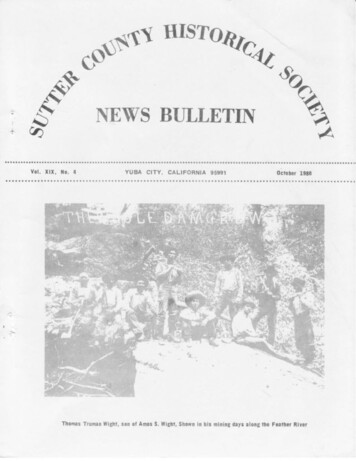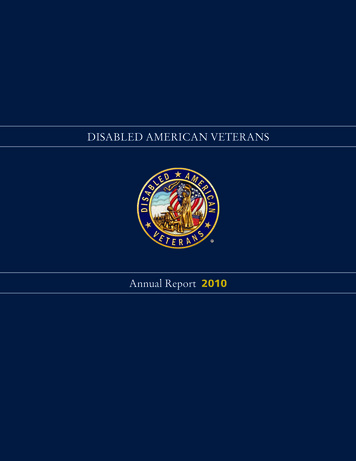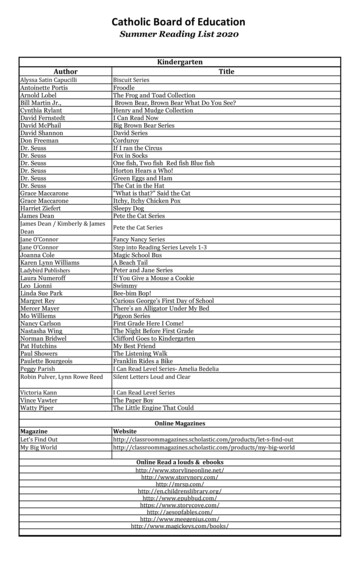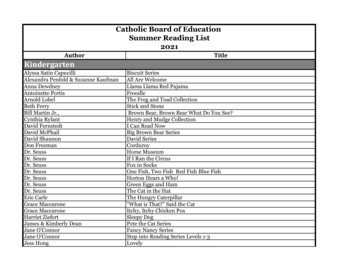![The History Of The DAV - Help Me, I'm A Disabled Veteran. [PDF]](/img/27/davhistory-davww.jpg)
Transcription
page 3page 2C H A P T E R1P ENCILS ON STREET C ORNERSWe had a common experience which boundus together, and we ought to continuethrough an organization of our own andorganization of us, by us and for us Robert S. Marx We grow great by dreams . Some of us let thesegreat dreams die, but others nourish and protectthem; nurse them through bad days till they[flourish]; bring them to the sunshine and light,which comes always to those who sincerely hopethat their dreams will come true. Woodrow Wilson W A R S&S C A R SCHAPTER1
page 4BREADLINEIT WAS A NATIONAL DISGRACE. THE GOVERNMENTHAD SENT A GENERATION OFF TO FIGHT A WAR, BUTSOMEHOW THE POLITICIANS FAILED TO FORESEE THATMANY WOULD COME HOME WOUNDED AND SICK. YETTHE DAY CAME WHEN WORLD WAR I CAME TO ANEND—NOVEMBER 11, 1918, AND THE NATION GASPEDAS THE DISABLED CAME HOME.WOUNDED, WORLD WAR IW A R S&S C A R SWASHINGTON, D.C., 1920SAll across our Nation, Americans saw the grim costof the fighting in Europe. Veterans returned withoutarms and legs. They were blind, deaf, or mentally ill.Their battle scars told the story of massive, poundingartillery and warfare mechanized to levels no onehad ever dreamed possible. Chemical warfare, usedextensively during the war, left men with gas-searedlungs, gasping for each breath. Prolonged and chronicillnesses would forever hamper the lives of hundredsof thousands of veterans returning from the horrorof rat-filled disease-ridden trenches.NEW YORK, 1920SThe Yanks saw combat in thirteen majoroperations of what was then called the Great WorldWar. Their participation in the fighting had tipped the scales in favor of saving WesternCivilization. The American soldier paid the price of freedom in both Europe and here athome with his or her blood and well-being.More than 4.7 million Americansserved, and 53,500 sacrificed their lives incombat. Accidents and illnesses, mostlydeadly influenza, took the lives of another63,000. An astonishing 204,000 Americansin uniform were wounded during the war.Just as the government had not beenready for war, it was poorly prepared todeal with the veterans who returned to ourshores after bravely defending the causeof freedom. This was particularly true inthe case of those who came home sickand wounded.
page 5page 4BREADLINEIT WAS A NATIONAL DISGRACE. THE GOVERNMENTHAD SENT A GENERATION OFF TO FIGHT A WAR, BUTSOMEHOW THE POLITICIANS FAILED TO FORESEE THATMANY WOULD COME HOME WOUNDED AND SICK. YETTHE DAY CAME WHEN WORLD WAR I CAME TO ANEND—NOVEMBER 11, 1918, AND THE NATION GASPEDAS THE DISABLED CAME HOME.WOUNDED, WORLD WAR IW A R S&S C A R SWASHINGTON, D.C., 1920SAll across our Nation, Americans saw the grim costof the fighting in Europe. Veterans returned withoutarms and legs. They were blind, deaf, or mentally ill.Their battle scars told the story of massive, poundingartillery and warfare mechanized to levels no onehad ever dreamed possible. Chemical warfare, usedextensively during the war, left men with gas-searedlungs, gasping for each breath. Prolonged and chronicillnesses would forever hamper the lives of hundredsof thousands of veterans returning from the horrorof rat-filled disease-ridden trenches.NEW YORK, 1920SThe Yanks saw combat in thirteen majoroperations of what was then called the Great WorldWar. Their participation in the fighting had tipped the scales in favor of saving WesternCivilization. The American soldier paid the price of freedom in both Europe and here athome with their blood and well-being.More than 4.7 million Americansserved, and 53,500 sacrificed their lives incombat. Accidents and illnesses, mostlydeadly influenza, took the lives of another63,000. An astonishing 204,000 Americansin uniform were wounded during the war.Just as the government had not beenready for war, it was poorly prepared todeal with the veterans who returned to ourshores after bravely defending the causeof freedom. This was particularly true inthe case of those who came home sickand wounded.In less than six months, half of the four million Americans in uniform were released frommilitary service. The post-war national economy was already deeply stressed, but the floodof war veterans looking for jobs or needing medical care made it terribly worse.Not only was the government at a loss about what to do with those it had sent offto war, it had very little to spend on programs for the veterans. Bythe time the war in Europe came to an end in 1918, it had drainedour country’s economic resources, sapping 43 percent of the grossnational product.OUR NATION’S CITIZENSBy the following year, four million Americans were jobless.For the next two years, recession and widespread unemploymentWITNESSED WAR-WOUNDEDcrippled the American economy. The veterans of World War I cameHEROES SITTING IN THE STREETSmarching home to a country that was notat all geared up to deal with the aftermathWITH TIN CUPS AND SIGNSof war.READING: “HELP ME, I’M AIn 1919, Congress cut job programs toone-fifth of their original budget. With littleDISABLED VETERAN.”money to operate, those programs weredoomed to failure. Veterans were on theirown to fend for themselves.Recession made finding any jobdifficult, especially for wounded warriors.Prejudice against handicapped people—even those whose injuries were the directresult of defending our country—kept manycapable and qualified, yet disabled veteransfrom finding work.Disabled veterans looking for medical help fared little better. There was no singlegovernment program like today’s Department of Veterans Affairs (VA). No governmentdepartment or agency could claim overall responsibility for the veterans. Rather, severaldifferent agencies were charged with the responsibility for veterans, and coordinationbetween them was extremely inefficient. This caused confusion, and these agenciesfrequently found themselves working atcross-purposes.Further, the government requiredan overwhelming number of forms, anddisabled veterans were sent on a paper chasefrom one agency to the next. Disillusionedveterans often found themselves back wherethey had started. Confronted by a series ofgovernment hurdles, some simply gave up.CHAPTER1
page 7page 6Our Nation’s citizens witnessed war-wounded heroessitting in the streets with tin cups and signs reading:“Help Me, I’m a Disabled Veteran.”The onset of a horrific epidemic of influenza didn’thelp matters at all. Bed space in hospitals chargedwith treating veterans was severely overtaxed by thecombined demand created by the flu epidemic and theEARLY VETERANS’ PUBLICATIONSneed to provide medical care for the war wounded. Toresolve this, the government contracted for space in private hospitals.Some disabled veterans were lucky to get cots in the hallways. Others slept on thefloor. Far too many were simply turned away.Some of the more mobile disabled veterans sought opportunity in the FederalVocational Training program. Getting access to this and other programs again requiredextensive paperwork. Qualification was based upon financial need, as well as the extent ornature of the disability.Most of the programs simply weren’t what they claimed to be. Funding of theseinitiatives was skimpy, and overwhelming numbers of veterans swamped availableresources. Of the 675,000 who applied for training under the Soldiers RehabilitationAct, less than half completed training. Of these, 6,600 remained unemployable. A full345,000 were denied any training at all. The programwas terminated in 1928.The Beginning of the DAVYOUNG MARXDuring the early post-war years, groups of disabledveterans were pulling themselves together invarious places across the Nation. Some of thesewere simply social clubs for veterans still rejoicingin victory and newfound camaraderie. Othersraised money and created work to help theirbrothers in arms who were left without themeans to support themselves.At Cincinnati’s Ohio MechanicsInstitute (OMI)—a training school fordisabled veterans—a group formedthe OMI Disabled Soldiers (OMIDS).To make their voices heard, theyasked for help from better-knowndisabled soldiers.W A R S&S C A R SCAPTAINROBERT S. MARXThese included Colonel Peter Traub,Commander of Fort Thomas across theriver in Kentucky, and Judge-Elect CaptainRobert S. Marx of Cincinnati.An infantry officer, Captain Marx hadthe distinction of capturing the furthermostpoint taken by the American Army priorto the Armistice. On arriving at this pointand finding all the officers dead or severelywounded, he took command. On November10, 1918, in the Meuse-Argonne Offensive,just hours before the last shot was fired,a German shell exploded over battalionheadquarters, killing three Americansoldiers and wounding four. Captain Marxwas among the injured.After months in a French hospital,Captain Marx was finally strong enough forthe trip home. Soon after returning to his lawpractice in Cincinnati, he won appointmentROBERT S. MARX ON A PILGRIMAGE TO THE WESTERN FRONT,to the Superior Court of Cincinnati. A man1920’Sof exceptional ability, he was subsequentlyelected to that office. Judge Marx was popular enough to be the only Democrat to beelected to office in Ohio in 1919.Christmas Day, 1919, brought a momentous turning point in the history of veterans’affairs, though it started out as nothing more than a Christmas party hosted by JudgeMarx at the request of the local community service agency.Gathered for a dinner at the Sinton Hotel and entertainment at the Lyric Theaterwere about a hundred disabled veterans.They were spending the holidays away OHIO MECHANICS INSTITUTE, 1920Sfrom home, recovering from war wounds,and receiving rehabilitation and vocationaltraining.The years that followed would showJudge Marx to have a real flair for organizing,a talent that showed up repeatedly asthe captain of infantry advanced to becomea captain of industry and philanthropy,as well as a leader in the realm ofveterans’ affairs.CHAPTER1
page 7page 6Our Nation’s citizens witnessed war-wounded heroessitting in the streets with tin cups and signs reading:“Help Me, I’m a Disabled Veteran.”The onset of a horrific epidemic of influenza didn’thelp matters at all. Bed space in hospitals chargedwith treating veterans was severely overtaxed by thecombined demand created by the flu epidemic and theEARLY VETERANS’ PUBLICATIONSneed to provide medical care for the war wounded. Toresolve this, the government contracted for space in private hospitals.Some disabled veterans were lucky to get cots in the hallways. Others slept on thefloor. Far too many were simply turned away.Some of the more mobile disabled veterans sought opportunity in the FederalVocational Training program. Getting access to this and other programs again requiredextensive paperwork. Qualification was based upon financial need, as well as the extent ornature of the disability.Most of the programs simply weren’t what they claimed to be. Funding of theseinitiatives was skimpy, and overwhelming numbers of veterans swamped availableresources. Of the 675,000 who applied for training under the Soldiers RehabilitationAct, less than half completed training. Of these, 6,600 remained unemployable. A full345,000 were denied any training at all. The programwas terminated in 1928.The Beginning of the DAVYOUNG MARXDuring the early post-war years, groups of disabledveterans were pulling themselves together invarious places across the Nation. Some of thesewere simply social clubs for veterans still rejoicingin victory and newfound camaraderie. Othersraised money and created work to help theirbrothers in arms who were left without themeans to support themselves.At Cincinnati’s Ohio MechanicsInstitute (OMI)—a training school fordisabled veterans—a group formedthe OMI Disabled Soldiers (OMIDS).To make their voices heard, theyasked for help from better-knowndisabled soldiers.W A R S&S C A R SCAPTAINROBERT S. MARXThese included Colonel Peter Traub,Commander of Fort Thomas across theriver in Kentucky, and Judge-Elect CaptainRobert S. Marx of Cincinnati.An infantry officer, Captain Marx hadthe distinction of capturing the furthermostpoint taken by the American Army priorto the Armistice. On arriving at this pointand finding all the officers dead or severelywounded, he took command. On November10, 1918, in the Meuse-Argonne Offensive,just hours before the last shot was fired,a German shell exploded over battalionheadquarters, killing three Americansoldiers and wounding four. Captain Marxwas among the injured.After months in a French hospital,Captain Marx was finally strong enough forthe trip home. Soon after returning to his lawpractice in Cincinnati, he won appointmentROBERT S. MARX ON A PILGRIMAGE TO THE WESTERN FRONT,to the Superior Court of Cincinnati. A man1920’Sof exceptional ability, he was subsequentlyelected to that office. Judge Marx was popular enough to be the only Democrat to beelected to office in Ohio in 1919.Christmas Day, 1919, brought a momentous turning point in the history of veterans’affairs, though it started out as nothing more than a Christmas party hosted by JudgeMarx at the request of the local community service agency.Gathered for a dinner at the Sinton Hotel and entertainment at the Lyric Theaterwere about a hundred disabled veterans.They were spending the holidays away OHIO MECHANICS INSTITUTE, 1920Sfrom home, recovering from war wounds,and receiving rehabilitation and vocationaltraining.The years that followed would showJudge Marx to have a real flair for organizing,a talent that showed up repeatedly asthe captain of infantry advanced to becomea captain of industry and philanthropy,as well as a leader in the realm ofveterans’ affairs.CHAPTER1
page 9page 8Perhaps Judge Marx directed conversationat the party to the topic of doing somethingabout the mess the government had made ofits programs for veterans. That was alwaysthe belief among the earliest members ofthe Disabled American Veterans (DAV), SINTON HOTEL, EXTERIORseveral of whom attended that party.Whether or not Judge Marx was the first to drop the topic into conversation, all thetalk soon turned to the need to form an organization through which disabled veteranscould make themselves heard in the halls of government.Before the evening was out, plans were made for a serious meeting to explore thelevel of interest in a new organization and to establish a broad outline of its goals. Duringthe first months of 1920, that Christmas dream was transformed into reality. A neworganization began to take shape: the Disabled American Veterans of the World War—theDAVWW.Two organized groups laid the initial groundwork. First, the OMIDS were already activeas a loosely formed self-help group. More than 400 veterans were receiving vocationaltraining at Ohio Mechanics Institute. As the DAVWW came together, these veteranswere represented by Institute President B.M. Treu, Raymond A. Lasance, and F. Sample.Second was a group of disabled veterans at the University of Cincinnati. They wereled by their newspaper editor, Charles C. Quintman, and their war-blinded chaplain, RabbiMichael Aaronsohn.During the spring of 1920, several meetings were held in Judge Marx’s office atthe Court House, not far from downtown Cincinnati, and at nearby Memorial Hall, agathering place for the city’s veterans. Judge Marx presented articles of confederation forthe DAVWW at an early meeting.At a May 21, 1920, gathering at Memorial Hall, Judge Marx reported he had been intouch with the War Department. He had learned that 741,000 veterans were eligible formembership in a group for disabled veterans. The seed had been planted.SINTON HOTEL, INTERIORW A R S&S C A R SCHAPTER1
page 9page 8Perhaps Judge Marx directed conversationat the party to the topic of doing somethingabout the mess the government had made ofits programs for veterans. That was alwaysthe belief among the earliest members ofthe Disabled American Veterans (DAV), SINTON HOTEL, EXTERIORseveral of whom attended that party.Whether or not Judge Marx was the first to drop the topic into conversation, all thetalk soon turned to the need to form an organization through which disabled veteranscould make themselves heard in the halls of government.Before the evening was out, plans were made for a serious meeting to explore thelevel of interest in a new organization and to establish a broad outline of its goals. Duringthe first months of 1920, that Christmas dream was transformed into reality. A neworganization began to take shape: the Disabled American Veterans of the World War—theDAVWW.Two organized groups laid the initial groundwork. First, the OMIDS were already activeas a loosely formed self-help group. More than 400 veterans were receiving vocationaltraining at Ohio Mechanics Institute. As the DAVWW came together, these veteranswere represented by Institute President B.M. Treu, Raymond A. Lasance, and F. Sample.Second was a group of disabled veterans at the University of Cincinnati. They wereled by their newspaper editor, Charles C. Quintman, and their war-blinded chaplain, RabbiMichael Aaronsohn.During the spring of 1920, several meetings were held in Judge Marx’s office atthe Court House, not far from downtown Cincinnati, and at nearby Memorial Hall, agathering place for the city’s veterans. Judge Marx presented articles of confederation forthe DAVWW at an early meeting.At a May 21, 1920, gathering at Memorial Hall, Judge Marx reported he had been intouch with the War Department. He had learned that 741,000 veterans were eligible formembership in a group for disabled veterans. The seed had been planted.SINTON HOTEL, INTERIORW A R S&S C A R SCHAPTER1
To make their voices heard, they asked for help from better-known disabled soldiers. These included Colonel Peter Traub, Commander of Fort Thomas across the river in Kentucky, and Judge-Elect Captain Robert S. Marx of Cincinnati. An infantry officer, Captain Marx had the distinction of capturing the furthermost











